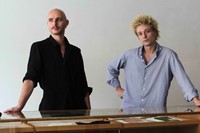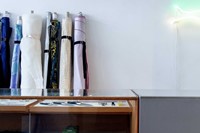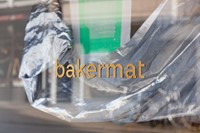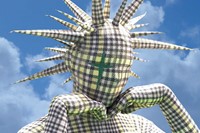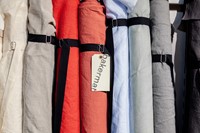Adding to the city’s reputation as a forward-thinking fashion capital is Bakermat, an innovative new brick-and-mortar store and textile supply platform founded by Cedric Jacquemyn and Quinten Schaap
- Who is it? Bakermat is an innovative textile supply platform and physical shop in Antwerp founded by Cedric Jacquemyn and Quinten Schaap
- Why do I want it? The platform strives to future-proof the textile industry by connecting designers with sustainable and ethical textile suppliers from across the globe
- Where can I find it? Bakermat is located at Kleine Markt 7, 2000 Antwerp, Belgium or online at bakermat.net
Who is it? When Cedric Jacquemyn set about launching his eponymous brand post-graduation from Antwerp’s Royal Academy of Arts, he encountered a crucial gap in his education: he didn’t know how to connect with textile suppliers. “Coming from the Academy, where the focus is on design and not so much materiality, it was a big issue to make the transition from being a student to an actual designer,” he reflects, “because I feel that the aesthetic of a brand is so much linked to the suppliers that you find.” So, after 15 years of personally developing a network, Jacquemyn partnered with Quinten Schaap to open his connections and knowledge to others via Bakermat, an innovative textile supply platform.
From their brick-and-mortar store in Antwerp and online digital library, Bakermat aims to “future-proof” the textile industry. Acting as an “agency” – a sort of middleman – they are able to provide both professionals and amateurs with access to materials that may have otherwise been out of reach due to large minimum order requirements, while reciprocally connecting suppliers with new, diversified audiences. “Covid did two things for suppliers: they had to start showing fabrics online which was hell as photos aren’t representative of textiles,” explains Jacquemyn, “and they realised they had to diversify their clientele in case of orders being cancelled.”
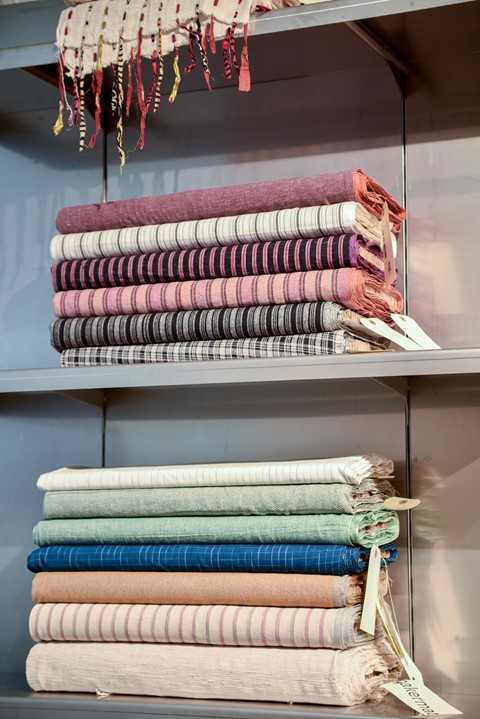
The shopfront is purposefully wedged between clothing stores on one of Antwerp’s main fashion streets to help educate consumers on the living, human tangibility of the textiles they wear. “Sustainability for us is also the exchange of savoir-faire and we want the shop to be a place of open dialogue,” says Jacquemyn. “People can come in, hear a story about a manufacturer because most consumers don’t understand how and where a fabric is made.” In this spirit of transparency, each textile is accompanied by a “verified supplier passport”: a complete briefing on where the fibre comes from, how it is dyed, and then where the textile is produced.
Why do I want it? Bakermat doesn’t rely on certifications to distinguish their suppliers (it’s often only the big companies that can afford them) – they vet partners according to their own tenets of social, environmental, and economic sustainability. For example, they work with small-scale manufacturers in India who assume an integral eco-responsibility down to the very seeds from which the fibres are grown, as well as established Italian heritage houses, whose practices may not be entirely environmentally responsible, but Bakermat deems that their centuries-old craftsmanship is worth protecting and promoting.
Each supplier they partner with benefits from Bakermat’s state-of-the-art digital library which is “built from physical, existing materials that we scan and make into 3D textures.” If this technology is already being used by big manufacturers, Schaap, who is head of digitisation, wants to make sure “small hand-weaving companies in India or old heritage houses in Italy” are also included in this digital transition. Through the granular precision of their scans, the library further reinforces the connection with the human hands behind it. “They are a real fabric, coming from a real supplier, being woven in a certain way,” explains Schaap. “When you look at other digital textures, they’re just representing a fabric but not the manufacturer or the person who made it.”

The digital library is also designed to help students and young designers for whom the financial and labour costs required to produce samples can often be prohibitive. As each textile’s properties are carefully replicated, designers can see exactly how the digital fabrics drape with prototyping software, before they choose to invest in the physical material. “The reality of a young brand is that the amount of clothing you sell is just not equal to the investment you’re making in the production process,” says Schaap. “So this is a way to make things a bit more manageable, practices a bit more sustainable for young designers.” Access to the online library is available via a subscription, and the physical textiles can then be ordered directly through Bakermat.
But Jacquemyn and Schaap are not only using this technology to look forward: they’ve recently partnered with MoMu, Antwerp’s fashion museum, to develop new conversation methods. “This is quite an important challenge as some materials, especially those that are coated, are very hard to preserve,” says Jacquemyn, “so how can digital and 3D play a role in this? How can we support conservation methods by digitising materials?”
Where can I find it? Bakermat is located at Kleine Markt 7, 2000 Antwerp, Belgium or online at bakermat.net.

